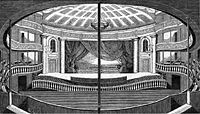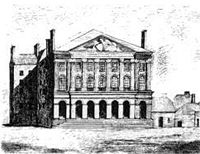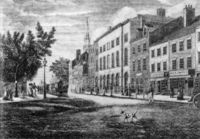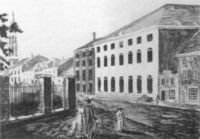New Park Theatre
(aka "Abbey's New Park Theatre" and "Park Theatre")
21-5 Park Row / New York City
![]()
- Park Theatre interior, 1822 -  - from New York Clipper Annual -
- from New York Clipper Annual -
![]()
 - from New York Clipper Annual -
- from New York Clipper Annual -
In the late 18th century, New York's only playhouse was the decaying and increasingly low-brow John Street Theatre. Tired of attending such an establishment, a group of wealthy New Yorkers began planning
the construction of a new playhouse in 1795. Investors bought 113 shares at $375 each to cover the estimated $42,375 cost. To plan the structure, the owners hired celebrated architect Marc Isambard Brunel,
a Frenchman who had fled to New York to avoid the Reign of Terror and was currently the city's engineer. Part way through construction, however, the project ran out of money. The owners sold more shares
for what would eventually mount to a construction cost of more than $130,000.



The completed three-story structure measured 80 feet (24 m) wide by 165 feet (50 m) deep and was made of plain dressed stone. The overall effect was an air of austerity. The interiors,
on the other hand, were quite lavish. The building followed the traditional European style of placing a gallery over three tiers of boxes, which overlooked the U-shaped pit.
The section of Manhattan where the theatre stood was not stylish: the New Theatre, as it was called, was neighbor to Bridewell Prison, a tent city's worth of squatters, and the local poorhouse.
Lewis Hallam, Jr., and John Hodgkinson, both members of the John Street Theatre company, obtained the building's lease. They hired remnants of the Colonial Old American Company to form the
nucleus of the theatre's in-house troupe and thus give the establishment the sheen of tradition and American culture. Meanwhile, the men quarreled, and construction continued languorously.
The theatre finally held its first performance on January 29, 1798, despite still being under construction. The gross was an impressive $1,232, and, according to theatre historian
T. Allston Brown, hundreds of potential patrons had to be turned away.
In its early years, the Park enjoyed little to no competition in New York City. Nevertheless, it rarely made a profit for its owners or managers, prompting them to sell it in 1805. Under the management of Stephen Price
and Edmund Simpson in the 1810s and 1820s, the Park enjoyed its most successful period. Price and Simpson initiated a star system by importing English talent and providing the theatre a veneer of upper-class respectability.
Rivals such as the Chatham Garden and Bowery theatres appeared in the 1820s, and the Park had to adapt to survive. Blackface acts and melodrama squeezed Italian opera and English drama out of their preferential positions.
Nevertheless, the theatre maintained its high-class image.

New York newspapers generally praised the New Theatre:
“ On Monday evening last, the New Theatre was opened to the most overflowing house that was ever witnessed in this city. Though the Commissioners have been constrained to open it in an unfinished
state, it still gave high satisfaction. The essential requisites of hearing and seeing have been happily attained. We do not remember to have been in any Theatre where the view of the stage is so
complete from all parts of the house, or where the actors are heard with such distinctness. The house is made to contain about 2,000 persons. The audience part, though wanting in those brilliant
decorations which the artists have designed for it, yet exhibited a neatness and simplicity which were highly agreeable. The stage was everything that could be wished. The scenery was executed in
a most masterly style. The extensiveness of the scale upon which the scenes are executed, the correctness of the designs, and the elegance of the painting, presented the most beautiful views which
the imagination can conceive. The scenery was of itself worth a visit to the theatre."
The theatre offered performances on Mondays, Wednesdays, Fridays, and Saturdays. William Dunlap eventually joined the management team. Hallam parted mid-season, and Hodgkinson
The theatre burnt down in May 1820. All but the exterior walls were destroyed. The owners rebuilt the following year.
In the early 1820s, the New Theatre was New York's only theatre, and this lack of competition proved its most profitable period. The Chatham Garden Theatre was built in 1823 and provided the first
Despite its upper-class luster, however, some commentators found due cause to criticize the Park. Frances Trollope gave a mixed review:
By the late 1830s, blackface acts and Bowery-style melodrama had come to eclipse traditional drama in popularity for New York audiences. Simpson adapted, booking more novelty acts
Edgar Allan Poe wrote a more critical editorial in the Broadway Journal:
The Park Theatre was destroyed by fire 18 December 1848. The Astor family opted not to rebuild it, the more fashionable clientèle having moved north to Washington Square and the Fifth Avenue;
As You Like It, 1786;
waited for season's end before doing the same. Dunlap remained as sole proprietor; his expenses were so great that he had to make at least $1,200 per week to break even. He left in
1805 after declaring bankruptcy. After a few more failed
Stephen Price became manager in 1808. He instituted a star system, whereby he paid English actors and actresses to play English dramas there. Price spent much of his time in England,
where he had a successful acting career, leaving much of the actual business of theatre management to Edmund Simpson. The Park at this point was already known for high-class entertainments,
but Price and Simpson's policies helped to reinforce this as they booked English drama, Italian opera, and other upper-class bills, such as actress Clara Fisher. Price and Simpson also
fostered the careers of many American performers, including Edwin Forrest and Charlotte Saunders Cushman.
real challenge to the Park's primacy; the Bowery Theatre followed in 1826. The New Theatre, having lost its newness, became known as the Park Theatre around this time. At first, each of the rivals
aimed for the same upper-class audience. However, by the late 1820s and early 1830s, the Bowery and Chatham Garden had begun to cater to a more working-class clientele. In comparison, the Park
became the theatre of choice for bon ton. This was helped by the evolution of its neighborhood. New York home owners had steadily moved northward from Bowling Green so that by this point, the Park
stood in an upper-class residential area and fronted City Hall and a large park. Coffeehouses and hotels soon followed.
“The piece was extremely well got up, and on this occasion we saw the Park Theatre to advantage, for it was filled with well-dressed company; but still we saw many 'yet unrazored lips' polluted with the
grim tinge of hateful tobacco, and heard, without ceasing, the spitting, which of course is its consequence. If their theatres had the orchestra of the Feydeau, and a choir of angels to boot, I could find
but little pleasure, so long as they were followed by this running accompaniment of thorough base.
and entertainments that emphasized spectacle over high culture. The patronage changed, as well, as the New York Herald noted:
“On Friday night the Park Theatre contained 83 of the most profligate and abandoned women that ever disgraced humanity; they entered in the same door, and for a time mixed indiscriminately
with 63 virtuous and respectable ladies. . . . Men of New York, take not your wives and daughters to the Park Theatre, until Mr. Simpson pays some respect to them by constructing a separate
entrance for the abandoned of the sex. ”
“The well-trained company of rats at the Park Theatre understand, it is said, their cue perfectly. It is worth the price of admission to see their performance. By long training they know precisely the time
when the curtain rises, and the exact degree in which the audience is spellbound by what is going on. At the sound of the bell [signaling the start of the show] they sally out; scouring the pit for chance
peanuts and orange-peel. When, by the rhyming couplets, they are made aware that the curtain is about to fall, they disappear—through the intensity of the performers. A profitable engagement
might be made, we think, with "the celebrated Dog Bill [part of William Cole's act in P. T. Barnum's
American Museum].”
instead they had stores constructed on the site.

Female Patriotism or Death of Joan d'Arc, 1798;
Hunchback; Andre, 1798, (3 performances);
She Would Be Soldier or The Plains of Chippewa, 1819;
Brutus or Fall of Tarquin, 1819;
Tale of the Neutral Ground, 1822;
Widow's Son or Which is the Traitor, 1825;
Midsummer Night's Dream, 1826;
Gladiator 1831, Lion of the West, 1831;
Hamlet 1832;
People's Lawyer, 1842, (1 performance);
Fashion or Life in New York, 1845, (20 performances);
Metamora or The Last of the Wampanoags. 1829;
Bianca Visconti or The Heart Overtasked, 1837;
In 1841 London Assurance ran for 3 weeks;
Spy;
Colonel Sellers, 1874, (119 performances);
Mighty Dollar 1875, (104 performances);
Our Boarding House, 1877 (104 performances);
Divorcons, 1882
(from ICQ Theatre Ring http://members.tripod.com/~clairsedore/RazzleDazzle/my_cdnow_store.html)
Programs available onsite from this theatre:
Return to Index of Theatres